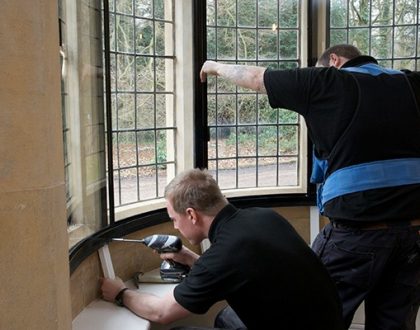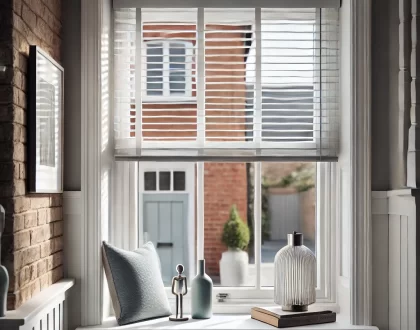A Beginner’s Guide to Window Insulation

As well as letting light into your property, windows should offer sufficient thermal insulation. Without the right window insulation, your home can become cold and draughty – especially through the winter. So, what can you do about it?
In this post, we discuss every aspect of window insulation, from why it’s important to how you can improve it.
The thermal envelope
Every building has a thermal envelope, which is a physical barrier between the conditioned interior and the unconditioned exterior of the property. It’s made up of the floor, walls and roof along with doors and windows.
When you think of your property’s heat insulation, most people correctly consider the floor, walls and the roof. That’s why the likes of loft and cavity wall insulation are so popular. However, it’s not uncommon for property owners to overlook a building’s fixtures.
In terms of heat retention, this can be devastating. Even with the most well-insulated walls, poorly insulated windows will draw warm air out of a building and let the cold air in. After all, they typically make up around 20 percent of walls’ surface area.
Problems with window insulation
There are a range of factors which can contribute to a window’s thermal insulation efficiency.
Poor glazing
The most common cause of window insulation problems is inefficient glazing. Essentially, if the glass doesn’t form an insulative barrier between the inside and outside of your home, it’s not doing its job. Single glazing has this problem because the single pane of glass becomes cold on the inside as the outside temperature drops.
Double glazing aims to solve this problem, by using two panes of glass with an insulative gap in between the two. However, this doesn’t always work, as there are additional problems that can occur even with double glazing in place…
Gaps around the frame
The next potential issue is window frame insulation. Regardless of your glazing type, there may be gaps around the window frame which let cold air in and warm air out. This could be a crack in the sealant between the frame and glass, or just damage to the frame itself.
Needless to say, this can make it near impossible to heat your property and maintain a comfortable temperature.
Closing mechanism not airtight
Another problem on some windows is the closing mechanism. Most windows have a hinged section or a sliding sash, which can be opened to keep your home well ventilated. However, they also need to be airtight when they close to maintain proper window insulation.
Any gaps in the moving section of your windows will allow cold air in and eliminate the insulation provided by the rest of the unit.
How to check window insulation
To test your windows’ thermal insulation, you essentially need to check for any of the points covered above.
Firstly, check the glazing itself by touching the inside of your windows. It’s best to try this on a cold day when the inside of your home is relatively warm. While they won’t be as warm as your home’s interior, they shouldn’t be as cold as the outside of the property.
To test for draughts around the window frame or closing mechanism, you can use a simple match test. Light a match and hold the flame carefully around each part of the window frame. If air is seeping in, it will blow the flame. This also works with an incense stick.
You can also check for moisture around the windows. When it’s raining outside, run your fingers around the frame to check for any dampness or droplets, along with wet patches on the windowsill. If water can get through the window frame, so too can cold air.
Improving window insulation
The good thing about window heat insulation is that it can be improved. Most sites you’ll find online will recommend new windows as a way to improve insulation. This should be treated as a last resort by property owners and isn’t necessarily the best option. For one, it’s out of the question if your property is listed or you just want to maintain its heritage appearance.
Fortunately, there are a range of options to strengthen the insulative barrier on existing windows and stop cold air seeping through.
1. Sealing off windows
If gaps in your window frame are causing poor insulation, it’s definitely worth having them re-sealed to see if it fixes the problem. One way of doing this is with caulking around the joints – between the frame and the wall. You can also try weather strips as a temporary solution. These are self-adhesive strips which can be applied on the inside of your windows for the same sealing effect.
If you have wooden window frames, you could also consider having any gaps or breaks repaired to eliminate the detriment to your windows’ insulation. While wood is liable to decay over time without the right maintenance, problems can be isolated and repaired by specialists if they’re caught early enough.
2. Dressing windows
Another option is to add insulation on the inside of your windows. Thick, lined curtains add an extra layer of insulation to your windows in winter, which can be easily removed or replaced with a lighter alternative in the warmer months.
Shutters work similarly, but can’t be removed as easily and block out a lot of light when used. As an additional measure, you can lay out draught snakes on your windowsill to stop some of the warm air escaping.
3. Transparent insulation for windows
When it comes to transparent window insulation, there are two options to choose from – secondary glazing and window insulation film.
To start with, insulation film is a plastic sheet which is applied on the inside of windows. After cutting to size, it simply needs to be heated to stick onto the surface of the window with a small improvement to your window’s insulation. The main downside here is that it’s not necessarily transparent. Insulation film can become cloudy, impacting the appearance of your windows.
On the other hand, secondary glazing improves thermal insulation by up to 60%. In simple terms, it means adding a discreet secondary window frame on the inside of existing windows. It has minimal impact on the aesthetics of windows, so you can maintain the style of your property. Best of all, it can reduce annual fuel bills by as much as 15%.
Get your window insulation kit
At Clearview, we provide high quality DIY secondary glazing kits for domestic and commercial customers across the UK. All kits are supplied fully assembled and installation-ready, with no preparation required on existing windows. Put simply, it’s an easy and effective way to improve the insulation of your windows.

Discover How To Stop Draughts for Good And Save On Your Energy Bills
This free eGuide – written by specialists – explains in simple terms how to improve the thermal efficiency of your windows by more than 60% and how you can reduce your yearly heating bill by 15%.
Simply enter your name and email below and we will send a free copy straight to your inbox.

 10 Year Guarantee
10 Year Guarantee 5 Star Customer Reviews
5 Star Customer Reviews

